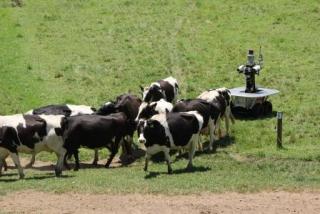Jan 30 2015
Sixty of the world’s top agricultural roboticists will meet next week (2-6 February) at the University of Sydney to discuss future directions for the globe’s horticultural and farming industries.
 University of Sydney agricultural robot Shrimp herds cattle in Camden
University of Sydney agricultural robot Shrimp herds cattle in Camden
Dr Robert Fitch, convener of the Summer School on Agricultural Robotics (SSAR), a first-of-its-kind meeting, says Australian and international experts will present research and discuss their ideas on the future of this rapidly advancing field.
“Technological innovation such as robotics could save the world’s agricultural industries,” says Dr Fitch, himself an expert in experimental robotics.
“Exciting new technologies including robotics has the potential to attract young people back to the sector which has experienced a steady decline over the past four decades in both environmental and human resources.”
“Interest in agricultural robotics is motivated by the need to improve the processes that will inevitably feed the planet,” he says.
“Historically agriculture has benefited from technical innovations, and now must respond to significant new demands and pressures to increase efficiency.”
Statistics show that the number of farmers in Australia has dropped by 40 percent since 1981. This decrease is due in part to the reluctance of young people to remain in family farms. Worse, nearly one quarter of farmers are at or above retirement age. Similar trends are present worldwide.
However, exciting new autonomous systems are already being developed for tasks such as pruning, thinning, harvesting, mowing, spraying, and weed removal.
University of Sydney’s Professor Salah Sukkarieh, an international expert in the research, development and commercialisation of field robotic systems says devices are also being developed that collect valuable real-time information that will enable new ways to estimate yield and reduce pesticide and herbicide use.
Increasing demand from Asia had prompted the Australian government to set aggressive targets for food production increases.
“One such target is to increase exports by 45 percent by year 2025, ” says Professor Sukkarieh.
“Because natural resources are limited, achieving such goals must involve increasing the efficiency of production while at the same time engaging in environmental stewardship, and contending with rising human labour costs and diminishing availability of human labour.”
NB: Photo opportunity - SSARs will include a field trip to the University of Sydney’s agricultural facility in Camden.